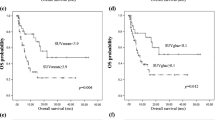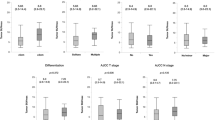Abstract
Background and purpose
Cholangiocarcinoma is an infrequent neoplasm barely studied with 18F-FDG–PET/CT. We evaluated the metabolic behavior of cholangiocarcinoma in PET/CT according to its location (intra or extrahepatic) and analyzed the relationship between metabolic parameters of the primary tumor and tumor markers (CA19-9 and CEA), determining their prognostic significance.
Methods
Retrospective study of PET/CT of 60 patients with untreated cholangiocarcinoma, divided into two groups according to tumor location. FDG uptake was evaluated visually and semiquantitatively [SUVmax and tumor-to-liver ratio (TLR)], and differences between intra and extrahepatic cholangiocarcinomas were tested, both for FDG uptake in the primary tumor and for the presence of regional or distant disease (per-patient), as well as regarding tumor marker levels. A correlation between metabolic parameters and tumor markers was performed, and prognostic value of these factors was determined (univariate and multivariate analyses).
Results
Intrahepatic cholangiocarcinomas were significantly more FDG-avid than extrahepatic ones (p = 0.006 for SUVmax; p = 0.002 for TLR). There were differences neither between both groups considering the capacity of PET/CT to detect regional (p = 0.261) and distant involvement (p = 0.876), nor regarding the levels of tumor markers (p = 0.160 for CA19-9; p = 0.708 for CEA). Metabolic parameters and tumor markers showed a weak positive correlation (R2 0.22–0.27). At the multivariate analysis, advanced stage (p = 0.024), increased CEA (p = 0.022), and higher TLR (p = 0.003) were significantly related with shorter overall survival.
Conclusions
Intra and extrahepatic cholangiocarcinomas behave differently on PET/CT, though no differences between both groups exist in its capacity to detect regional or distant disease. Metabolic parameters and levels of tumor markers seem to relate with tumor burden, impacting in prognosis.




Similar content being viewed by others
References
Khan SA, Toledano MB, Taylor-Robinson SD. Epidemiology, risk factors, and pathogenesis of cholangiocarcinoma. HPB (Oxf). 2008;10:77–82.
Charbel H, Al-Kawas FH. Cholangiocarcinoma: epidemiology, risk factors, pathogenesis, and diagnosis. Curr Gastroenterol Rep. 2011;13:182–7.
Razumilava N, Gores GJ. Cholangiocarcinoma. Lancet. 2014;383:2168–79.
Altekruse SF, Petrick JL, Rolin AI, Cuccinelli JE, Zou Z, Tatalovich Z, McGlynn KA. Geographic variation of intrahepatic cholangiocarcinoma, extrahepatic cholangiocarcinoma, and hepatocellular carcinoma in the United States. PLoS One. 2015;10:e0120574.
Palmer WC, Patel T. Are common factors involved in the pathogenesis of primary liver cancers? A meta-analysis of risk factors for intrahepatic cholangiocarcinoma. J Hepatol. 2012;57:69–76.
Edge SB, Compton CC. The American joint committee on cancer: the 7th edition of the AJCC cancer staging manual and the future of TNM. Ann Surg Oncol. 2010;17:1471–4.
Horgan AM, Amir E, Walter T, Knox JJ. Adjuvant therapy in the treatment of biliary tract cancer: a systematic review and meta-analysis. J Clin Oncol. 2012;30:1934–40.
Petrowsky H, Wildbrett P, Husarik DB, Hany TF, Tam S, Jochum W, Clavien PA. Impact of integrated positron emission tomography and computed tomography on staging and management of gallbladder cancer and cholangiocarcinoma. J Hepatol. 2006;45:43–50.
Corvera CU, Blumgart LH, Akhurst T, DeMatteo RP, D’Angelica M, Fong Y, Jarnagin WR. 18F-fluorodeoxyglucose positron emission tomography influences management decisions in patients with biliary cancer. J Am Coll Surg. 2008;206:57–65.
Khan SA, Davidson BR, Goldin R, Heaton N, Karani J, Pereira SP, Rosenberg WM, Tait P, Taylor-Robinson SD, Thillainayagam AV, Thomas HC, Wasan H. British society of gastroenterology. Guidelines for the diagnosis and treatment of cholangiocarcinoma: an update. Gut. 2012;61:1657–69.
Gores GJ. Early detection and treatment of cholangiocarcinoma. Liver Transpl. 2000;6:S30–4.
Patel AH, Harnois DM, Klee GG, LaRusso NF, Gores GJ. The utility of CA 19-9 in the diagnoses of cholangiocarcinoma in patients without primary sclerosing cholangitis. Am J Gastroenterol. 2000;95:204–7.
Annunziata S, Caldarella C, Pizzuto DA, Galiandro F, Sadeghi R, Giovanella L, Treglia G. Diagnostic accuracy of fluorine-18-fluorodeoxyglucose positron emission tomography in the evaluation of the primary tumor in patients with cholangiocarcinoma: a meta-analysis. Biomed Res Int. 2014;2014:247693.
Albazaz R, Patel CN, Chowdhury FU, Scarsbrook AF. Clinical impact of FDG PET–CT on management decisions for patients with primary biliary tumours. Insights Imaging. 2013;4:691–700.
Oliveira IS, Kilcoyne A, Everett JM, Mino-Kenudson M, Harisinghani MG, Ganesan K. Cholangiocarcinoma: classification, diagnosis, staging, imaging features, and management. Abdom Radiol (NY). 2017;42:1637–49.
Arellano RS, Sahani DV. Imaging of Cholangiocarcinoma. Dig Dis Interv. 2017;1:8–13.
Kim JY, Kim MH, Lee TY, Hwang CY, Kim JS, Yun SC, Lee SS, Seo DW, Lee SK. Clinical role of 18F-FDG PET–CT in suspected and potentially operable cholangiocarcinoma: a prospective study compared with conventional imaging. Am J Gastroenterol. 2008;103:1145–51.
Choi EK, Yoo IR, Kim SH, O JH, Choi WH, Na SJ, Park SY. The clinical value of dual-time point 18F-FDG PET/CT for differentiating extrahepatic cholangiocarcinoma from benign disease. Clin Nucl Med. 2013;38:e106–11.
Park TG, Yu YD, Park BJ, Cheon GJ, Oh SY, Kim DS, Choe JG. Implication of lymph node metastasis detected on 18F-FDG PET/CT for surgical planning in patients with peripheral intrahepatic cholangiocarcinoma. Clin Nucl Med. 2014;39:1–7.
Jiang L, Tan H, Panje CM, Yu H, Xiu Y, Shi H. Role of 18F-FDG PET/CT Imaging in Intrahepatic cholangiocarcinoma. Clin Nucl Med. 2016;41:1–7.
Wei M, Lü L, Lin P, Chen Z, Quan Z, Tang Z. Multiple cellular origins and molecular evolution of intrahepatic cholangiocarcinoma. Cancer Lett. 2016;379:253–61.
Sekiya S, Suzuki A. Intrahepatic cholangiocarcinoma can arise from Notch-mediated conversion of hepatocytes. J Clin Invest. 2012;122:3914–8.
Cardinale V, Carpino G, Reid L, Gaudio E, Alvaro D. Multiple cells of origin in cholangiocarcinoma underlie biological, epidemiological and clinical heterogeneity. World J Gastrointest Oncol. 2012;4:94–102.
Sakamoto Y, Kokudo N, Matsuyama Y, Sakamoto M, Izumi N, Kadoya M, Kaneko S, Ku Y, Kudo M, Takayama T, Nakashima O. Liver Cancer study group of Japan. Proposal of a new staging system for intrahepatic cholangiocarcinoma: analysis of surgical patients from a nationwide survey of the liver cancer study group of Japan. Cancer. 2016;122:61–70.
Anderson CD, Rice MH, Pinson CW, Chapman WC, Chari RS, Delbeke D. Fluorodeoxyglucose PET imaging in the evaluation of gallbladder carcinoma and cholangiocarcinoma. J Gastrointest Surg. 2004;8:90–7.
Moon CM, Bang S, Chung JB, Park SW, Song SY, Yun M, Lee JD. Usefulness of 18F-fluorodeoxyglucose positron emission tomography in differential diagnosis and staging of cholangiocarcinomas. J Gastroenterol Hepatol. 2008;23:759–65.
Suzuki H, Komuta M, Bolog A, Yokobori T, Wada S, Araki K, Kubo N, Watanabe A, Tsukagoshi M, Kuwano H. Relationship between 18-F-fluoro-deoxy-d-glucose uptake and expression of glucose transporter 1 and pyruvate kinase M2 in intrahepatic cholangiocarcinoma. Dig Liver Dis. 2015;47:590–6.
Hyder O, Hatzaras I, Sotiropoulos GC, Paul A, Alexandrescu S, Marques H, Pulitano C, Barroso E, Clary BM, Aldrighetti L, Ferrone CR, Zhu AX, Bauer TW, Walters DM, Groeschl R, Gamblin TC, Marsh JW, Nguyen KT, Turley R, Popescu I, Hubert C, Meyer S, Choti MA, Gigot JF, Mentha G, Pawlik TM. Recurrence after operative management of intrahepatic cholangiocarcinoma. Surgery. 2013;153:811–8.
Lee Y, Yoo IR, Boo SH, Kim H, Park HL, Hyun OJ. The role of F-18-FDG PET/CT in intrahepatic cholangiocarcinoma. Nucl Med Mol Imaging. 2017;51:69–78.
Lee JY, Kim HJ, Yim SH, Shin DS, Yu JH, Ju DY, Park JH, Park DI, Cho YK, Sohn CI, Jeon WK, Kim BI. Primary tumor maximum standardized uptake value measured on 18F-fluorodeoxyglucose positron emission tomography-computed tomography is a prognostic value for survival in bile duct and gallbladder cancer. Korean J Gastroenterol. 2013;62:227–33.
Song JY, Lee YN, Kim YS, Kim SG, Jin SJ, Park JM, Choi GS, Chung JC, Lee MH, Cho YH, Choi MH, Kim DC, Choi HJ, Moon JH, Lee SH, Jeong SW, Jang JY, Kim HS, Kim BS. Predictability of preoperative 18F-FDG PET for histopathological differentiation and early recurrence of primary malignant intrahepatic tumors. Nucl Med Commun. 2015;36:319–27.
Author information
Authors and Affiliations
Corresponding author
Ethics declarations
Conflicts of interest
The authors declare that they have no conflicts of interest.
Ethical approval
This is a retrospective work involving human participants. The final manuscript was revised and approved by the Ethics Committee of our institution.
Informed consent
Informed consent was waived due to its retrospective nature, though prior to data analysis, all patients were de-identified, and confidential information was protected according to national standards.
Rights and permissions
About this article
Cite this article
Sabaté-Llobera, A., Gràcia-Sánchez, L., Reynés-Llompart, G. et al. Differences on metabolic behavior between intra and extrahepatic cholangiocarcinomas at 18F-FDG–PET/CT: prognostic implication of metabolic parameters and tumor markers. Clin Transl Oncol 21, 324–333 (2019). https://doi.org/10.1007/s12094-018-1926-0
Received:
Accepted:
Published:
Issue Date:
DOI: https://doi.org/10.1007/s12094-018-1926-0




